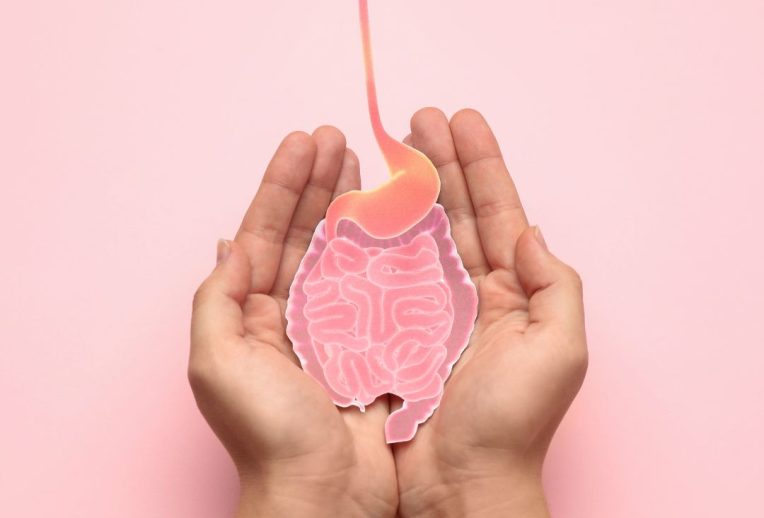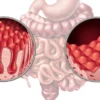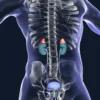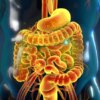
IBS is a very common digestive condition that impacts the lives of approximately 20% of the adult population at some point in their lives. While common symptoms of IBS include bloating, abdominal pain and changes in bowel function (eg diarrhoea or constipation), further symptoms can be present.
Approximately 60% of those with IBS report reactions to foods, or at least that their symptoms increase following a meal. It can be common for a component of this to be a reaction to dietary fat. This can be related to changes in how the fat is digested and absorbed, but this can also be related to the malabsorption of bile acids.
This article will discuss how bile acid malabsorption occurs, how it can be assessed and how it can be treated.
What is Bile Acid Malabsorption?
Bile acid malabsorption is a condition that presents with the main symptom of diarrhoea. This is also commonly referred to as bile acid diarrhoea.
There can be several underlying factors that may contribute to poor reabsorption of bile acids in the intestines. Before reviewing these, it’s important to understand the role of bile acids in digestive health and how they are meant to be absorbed.
What are Bile Acids?
Bile acids are a natural and healthy part of the digestive process to aid in the digestion of dietary fats and absorb certain nutrients. These include the fat-soluble vitamins, vitamins A, D, E and K.
Bile acids are produced in the liver and then stored in the gallbladder. From there, they are released into the small intestine to digest fats from food into a form that makes it easier to absorb.
What is Malabsorption?
Under normal and healthy circumstances, approximately 95% of bile acids are reabsorbed towards the end of the small intestine in a section called the terminal ileum.
This is a process that essentially recycles bile acids and returns them to the liver and then the gallbladder to be used again. The technical name for this process is enterohepatic circulation.
The term malabsorption refers to the abnormal absorption of substances across the digestive tract. In some cases, this can refer to sugars found in foods, such as fructose, as well as digestive enzymes such as bile acids. Therefore, bile acid malabsorption can be considered the abnormal reabsorption of bile acids from the intestines back into circulation.
Who Does Bile Acid Malabsorption Affect?
There is a range of risk factors that can lead to bile acid malabsorption.
The main group who are affected by bile acid malabsorption are those with preexisting digestive issues.
These can be distressing conditions, such as:
- Crohn’s disease (especially if the ileum is inflamed or has been surgically removed)
- Irritable Bowel Syndrome – Particularly diarrhoea-predominant IBS
- Celiac disease – When poorly controlled or undiagnosed
- Chronic pancreatitis
As well as these organic disease states, those who have had surgery to the small intestine or the removal of the gallbladder can be more likely to experience bile acid malabsorption.
These surgeries and interventions include:
- Ileal resection or bypass (e.g., for Crohn’s disease or cancer)
- Gallbladder removal (cholecystectomy) – Can cause bile to continuously trickle into the intestine, leading to diarrhoea in some
- Bariatric surgery – Procedures like gastric bypass can alter bile flow and absorption
Older patients are more likely to be affected by bile acid malabsorption. This can be due age related changes in the digestive system. It’s also more likely for older patients to have surgeries throughout their lives that may lead to malabsorption of bile.
What are the Symptoms of Bile Acid Malabsorption?
A wide range of digestive and gut symptoms is commonly seen in bile acid malabsorption.
It’s rare for all of these to be present in all cases of bile acid malabsorption, however, common symptoms include:
- Ongoing or Chronic Diarrhoea
- The most common symptom, which can be daily or intermittent
- Watery, urgent stools often occurring multiple times a day
- Often worsens after eating
- Urgent Bowel Movements
- Sudden, difficult-to-control urges
- Faecal Incontinence
- Not always present, but the involuntary leakage of stool. Often more likely with severe urgency or occurs overnight.
- Abdominal Pain or Cramping
- More common as lower abdominal discomfort
- May be relieved by bowel movements, but in some cases, passing a stool can increase pain or sensation of irritation.
- Bloating and Excess Gas
- Caused by bile acids irritating the gut lining and altering the gut microbiome.
- Flatulence and Gas
- Often frequent and foul-smelling
- Fatigue
- Likely due to disrupted digestion, dehydration, and poor nutrient absorption
- Weight Loss (less common)
- In cases of severe or untreated BAM
What Causes Bile Acid Malabsorption?
When considering the underlying causes of Bile acid malabsorption, there are 3 main subtypes.
These are considering the underlying mechanisms involved in bile acid not being appropriately reabsorbed in the bowel.
Type 1 BAM
Bile acid malabsorption, secondary to ileal resection, or ileal inflammation
- Possible causes include Crohn’s disease, ileal resections
Type 2 BAM
- Idiopathic/primary bile acid malabsorption refers to bile acid malabsorption with no known cause
Type 3 BAM
Secondary to various gastrointestinal diseases
- Cholecystectomy, small intestinal bacterial overgrowth, post radiation, coeliac disease, chronic pancreatitis
How is Bile Acid Malabsorption Diagnosed?
Bile acid malabsorption is diagnosed based on factors such as symptoms, health history and testing.
From a clinical perspective, the symptoms of bile acid diarrhoea can often overlap with those seen in IBS-D. This means that further tests may be required to assess malabsorption of diarrhoea.
While 2 main tests are available, the trial of a medication used to treat bile acid malabsorption can often be a quicker and more reliable way to assess, by jumping straight to treatment. This would be with a therapeutic trial of a bile acid sequestrant such as cholestyramine.
In other cases, when tests are used, the 2 tests considered are:
- SeHCAT Scan (Selenium Homocholic Acid Taurine Test)
- Blood Tests (e.g., Serum 7α-hydroxy-4-cholesten-3-one or C4) – often used when a SeHCAT test is not available.
Management and Treatment
Treatment of bile acid malabsorption depends on the causes and subtype of the condition.
In cases where there is damage to the same intestine or the cause is unknown, the long-term use of bile acid sequestrant medication is considered.
As bile is released in response to the ingestion of dietary fat, longer-term management can be focused on by following a low-fat diet. This can be in the region of having less than 20% of calories in the diet come from fat but this often needs to be asses on a case by cases basis.
What is the Best Medicine for Bile Acid Malabsorption?
In cases of mild to moderate bile acid malabsorption, the first-line treatment is typically cholestyramine. This is a medication that binds to bile acids in the bowel and prevents them from triggering inflammation. However, as it has a gritty texture, this is an issue for many patients.
Another option is Colesevelam. This offers similar benefits but comes in a tablet form, so it is easier to take and doesn’t have the gritty aspect. This can be as effective, but is also more expensive, which is an important consideration.
What are the Potential Side Effects of the Treatment?
Certain medications have side effects that include:
| Medication | Possible Side Effects |
| Cholestyramine |
|
| Colesevelam |
|
| Colestipol |
|
Outlook / Prognosis
The outlook and long-term prognosis of bile acid malabsorption can vary depending on the underlying cause, the severity, and the response to the various approaches already discussed.
Is Bile Malabsorption Curable?
For the most part, bile acid malabsorption is not considered curable, but it can be well managed with appropriate medications and dietary considerations. However, this can depend on the subtype of bile acid malabsorption and whether this can be treated.
For example, if the issue is caused by a form of irritation or microbial imbalance in the small intestine, addressing this should resolve the bile acid issue.
Living With BAM
For those living with bile acid malabsorption, this can lead to an ongoing issue that can impact quality of life.
What Triggers Bile Acid Malabsorption Symptoms?
A range of triggers that can lead to bile acid malabsorption, starting in the first place, such as IBD, surgery and infections.
The most common trigger for the acute onset or increase in symptoms is fatty or greasy foods. This is due to high-fat meals stimulating bile production, which can worsen symptoms if bile acids aren’t properly reabsorbed.
When Should I See My Healthcare Provider About Bile Acid Diarrhoea?
If digestive symptoms of most kinds persist for a prolonged period, a trip to the doctor is often a good idea.
When related to bile acid diarrhoea, this may be more relevant when the main symptom is loose stool and is accompanied by factors that include:
- Symptoms occur frequently (multiple times per day or several days a week)
- The bowel movements are watery, urgent, or disrupt daily life
- Symptoms are accompanied by weight loss, bloating, or abdominal pain
- Onset of symptoms followed gallbladder removal or bowel surgery
- Symptoms are not improving with standard treatments for IBS or diarrhoea
Conclusion
Bile acid malabsorption and diarrhoea can have a significant impact of the quality of life—both in the short term and the long term.
While several of the causes may mean this condition needs to be managed with medications, many of the causes can be addressed to resolve issues.
Contact us today for a gut health assessment to help take back control of your gut health.
References
- NHS – Bile Acid Malabsorption
- British Society of Gastroenterology – Bile Acid Diarrhoea (BAD): Information for Patients
- National Institute for Health and Care Excellence (NICE) – Bile Acid Malabsorption: NICE CKS
- Mayo Clinic – Bile Acid Diarrhoea: Causes and Treatments
- WebMD – Bile Acid Malabsorption Overview
- Patient.info – Bile Acid Diarrhoea
- Healthline – Understanding Bile Acid Malabsorption
- PubMed Central (NIH) – Bile Acid Malabsorption: A Common Cause of Chronic Diarrhea
- Cleveland Clinic – Bile Acid Diarrhoea (Malabsorption)
Last Updated
Uploaded by Martin Cohen on 11/06/2025






